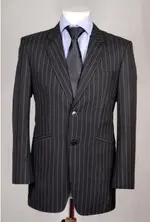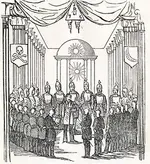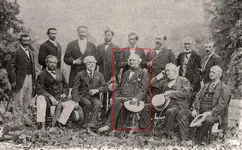NEW UNIFORM FOR SECOND AND THIRD GENERATION
View attachment 888221 OLD K.G.C. UNIFORM FROM FIRST GENERATION
View attachment 888225
L.C. BAKER

Following Judah Benjamin's relocation to the United Kingdom, he became a distinguished barrister and in 1872 was appointed a Queen's Counsel. A barrister is not an attorney and is usually forbidden, either by law or professional rules or both, from "conducting" litigation. This means that, while the barrister speaks on the client's behalf in court, he or she can do so only when instructed by a solicitor or certain other qualified professional clients, such as patent agents
if the K.G.C. took over the country during the reconstruction, It would start by forming a bank. In 1857 there was a panic. (Read about it) Not a good year for starting up a banking venture unless you had gold and were able to back up the money you were printing...... the k.G.C. would own the reserve literally.
Just keep in mind that OLD MONEY MAKES NEW MONEY And the K.G.C. had tons of old money just laying around to draw from to partner up with. So it could have went like this..............
J.P.Morgan went into banking in 1857 at the London branch of merchant banking firm, Peabody, Morgan & Co., a partnership between his father and George Peabody founded three years earlier in 1853.(first generation K.G.C.) Peabody first visited the United Kingdom in 1827 for business reasons, and over the next decade made four more trans-Atlantic trips, establishing a branch office in Liverpool, and later the banking firm of "George Peabody & Company" in London. In 1837, he took up permanent residence in London, remaining there for the rest of his life. So did Judah Benjamin after the Civil War as a barrister and eventually Queens Council. FOR PATENTS
In February 1867, on one of several return visits to the United States, and at the height of his financial success, Peabody's name was suggested by Francis Preston Blair, an old crony of sixth President Andrew Jackson and an active power in the smoldering Democratic Party as a possible Secretary of the Treasury in the cabinet of seventeenth President Andrew Johnson. At about the same time, his name was also mentioned in newspapers as a future presidential candidate. A merchant bank is a financial institution that provides capital to companies in the form of share ownership instead of loans. A merchant bank also provides advisory on corporate matters to the firms they lend to. (K.G.C. HAD GOLD DURING PANIC OF 1857 THEY WERE NOT PANICkING, BECAUSE THEY STARTED THE PANIC TO GET RID OF THE COMPETITION) In 1858 he moved to New York City to join the banking house of Duncan, Sherman & Company, the American representatives of George Peabody and Company. From 1860 to 1864, as J. Pierpont Morgan & Company, he acted as agent in New York for his father's firm, renamed "J.S. Morgan & Co." upon Peabody's retirement in 1864. From 1864 to 1872, he was a member of the firm of Dabney, Morgan, and Company. In 1871, he partnered with the Drexels of Philadelphia to form the New York firm of Drexel, Morgan & Company. Anthony J. Drexel became Pierpont's mentor at the request of Junius Morgan.
Treasury gold
In 1895, at the depths of the Panic of 1893, the Federal Treasury was nearly out of gold. President Grover Cleveland accepted Morgan's offer to join with the Rothschilds and supply the U.S. Treasury with 3.5 million ounces of gold to restore the treasury surplus in exchange for a 30-year bond issue. The episode saved the Treasury but hurt Cleveland with the agrarian wing of the Democratic Party and became an issue in the election of 1896, when banks came under a withering attack from William Jennings Bryan. Morgan and Wall Street bankers donated heavily to Republican William McKinley, who was elected in 1896 and reelected in 1900.
Steel
After the death of his father in 1890, Morgan took control of J. S. Morgan & Co. which was renamed Morgan, Grenfell & Company in 1910. Morgan began talks with Charles M. Schwab, president of Carnegie Co., and businessman Andrew Carnegie in 1900. The goal was to buy out Carnegie's steel business and merge it with several other steel, coal, mining and shipping firms to create the United States Steel Corporation. His goal was almost completed in late 1900 while negotiating a deal with Robert D. Tobin and Theodore Price III, but was then retracted immediately. In 1901 U.S. Steel was the first billion-dollar company in the world, having an authorized capitalization of $1.4 billion, which was much larger than any other industrial firm and comparable in size to the largest railroads.
U.S. Steel aimed to achieve greater economies of scale, reduce transportation and resource costs, expand product lines, and improve distribution. It was also planned to allow the United States to compete globally with Britain and Germany. U.S. Steel's size was claimed by Charles M. Schwab and others to allow the company to pursue distant international markets-globalization. U.S. Steel was regarded as a monopoly by critics, as the business was attempting to dominate not only steel but also the construction of bridges, ships, railroad cars and rails, wire, nails, and a host of other products. With U.S. Steel, Morgan had captured two-thirds of the steel market, and Schwab was confident that the company would soon hold a 75 percent market share. However, after 1901 the businesses' market share dropped. Schwab resigned from U.S. Steel in 1903 to form Bethlehem Steel, which became the second largest U.S. producer on the strength of such innovations as the wide flange "H" beam—precursor to the I-beam—widely used in construction.
The Panic of 1907 was a financial crisis that almost crippled the American economy. Major New York banks were on the verge of bankruptcy and there was no mechanism to rescue them until Morgan stepped in personally and took charge, resolving the crisis. Treasury Secretary George B. Cortelyou earmarked $35 million of federal money to quell the storm but had no easy way to use it. Morgan now took personal charge, meeting with the nation's leading financiers in his New York mansion; he forced them to devise a plan to meet the crisis. James Stillman, president of the National City Bank, also played a central role. Morgan organized a team of bank and trust executives which redirected money between banks, secured further international lines of credit, and bought plummeting stocks of healthy corporations. A delicate political issue arose regarding the brokerage firm of Moore and Schley, which was deeply involved in a speculative pool in the stock of the Tennessee Coal, Iron and Railroad Company. Moore and Schley had pledged over $6 million of the Tennessee Coal and Iron (TCI) stock for loans among the Wall Street banks. The banks had called the loans, and the firm could not pay. If Moore and Schley should fail, a hundred more failures would follow and then all Wall Street might go to pieces. Morgan decided they had to save Moore and Schley. TCI was one of the chief competitors of U.S. Steel and it owned valuable iron and coal deposits. Morgan controlled U.S. Steel and he decided it had to buy the TCI stock from Moore and Schley. Judge Gary, head of U.S. Steel, agreed, but was concerned there would be antitrust implications that could cause grave trouble for U.S. Steel, which was already dominant in the steel industry. Morgan sent Gary to see President Theodore Roosevelt, who promised legal immunity for the deal. U.S. Steel thereupon paid $30 million for the TCI stock and Moore and Schley was saved. The announcement had an immediate effect; by November 7, 1907, the panic was over. Vowing to never let it happen again, and realizing that in a future crisis there was not likely to be another Morgan, banking and political leaders, led by Senator Nelson Aldrich devised a plan that became the Federal Reserve System in 1913. The crisis underscored the need for a powerful mechanism, and Morgan supported the move to create the Federal Reserve System.
While conservatives in the Progressive Era hailed Morgan for his civic responsibility, his strengthening of the national economy, and his devotion to the arts and religion, the left wing viewed him as one of the central figures in the system it rejected. Morgan redefined conservatism in terms of financial prowess coupled with strong commitments to religion and high culture.
Enemies of banking attacked Morgan for the terms of his loan of gold to the federal government in the 1895 crisis and for the financial resolution of the Panic of 1907. They also attempted to attribute to him the financial ills of the New York, New Haven and Hartford Railroad. In December 1912, Morgan testified before the Pujo Committee, a subcommittee of the House Banking and Currency committee. The committee ultimately concluded that a small number of financial leaders was exercising considerable control over many industries. The partners of J.P. Morgan & Co. and directors of First National and National City Bank controlled aggregate resources of $22.245 billion, which Louis Brandeis, later a U.S. Supreme Court Justice, compared to the value of all the property in the twenty-two states west of the Mississippi River.
n 1890–1913, 42 major corporations were organized or their securities were underwritten, in whole or part, by J.P. Morgan and Company. (K.G.C.?)
Industrials
American Bridge Company
American Telephone & Telegraph
Associated Merchants
Atlas Portland Cement
Boomer Coal & Coke
Federal Steel Company
General Electric
Hartford Carpet Corporation
Inspiration Consolidated Copper
International Harvester
International Mercantile Marine
J. I. Case Threshing Machine
National Tube
United Dry Goods
Railroads
Atchison, Topeka and Santa Fe Railway
Atlantic Coast Line
Central of Georgia Railroad
Chesapeake & Ohio Railroad
Chicago & Western Indiana Railroad
Chicago, Burlington & Quincy
Chicago Great Western Railway
Chicago, Indianapolis & Louisville Railroad
Elgin, Joliet & Eastern Railway
Erie Railroad
Florida East Coast Railway
Hocking Valley Railway
Lehigh Valley Railroad
Louisville and Nashville Railroad
New York Central System
New York, New Haven & Hartford Railroad
New York, Ontario and Western Railway
Northern Pacific Railway
Pennsylvania Railroad
Pere Marquette Railroad
Reading Railroad
St. Louis & San Francisco Railroad
Southern Railway
Terminal Railroad Association of St. Louis








 ) The true Rebel is like a GAME COCK, you have to kill every feather on him, cut off his head and hide it from him! They were not about to lay down and take it. They got smarter,(which is what a good butt whipping will do for ya) and they made new objectives. If they couldn't win with force then they would win with brains, and that is what they accomplished.
) The true Rebel is like a GAME COCK, you have to kill every feather on him, cut off his head and hide it from him! They were not about to lay down and take it. They got smarter,(which is what a good butt whipping will do for ya) and they made new objectives. If they couldn't win with force then they would win with brains, and that is what they accomplished. L.C. Baker
L.C. Baker
